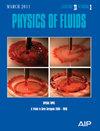评估低渗透致密油藏压裂注水能量补充的快速可靠半分析方法
IF 4.1
2区 工程技术
Q1 MECHANICS
引用次数: 0
摘要
低渗透和致密油藏的开发面临着天然能量不足和产量快速下降的挑战。压裂-注水技术是一种依靠高压、大体积流体注入来补充储层能量的技术,是快速提高地层能量的重要方法。为评估压裂-注水技术在低渗透致密储层中的能量补充效果,本研究提出了一种半解析快速计算方法。该方法采用了无量纲简化、Pedrosa 代换、拉普拉斯变换和 Stehfest 反演等方法,得出了刺激区和外部基质区各自不同流动能力的压力解。储层的平均地层压力(AFP)采用面积加权平均法确定,并使用商业模拟器进行数值验证。一项来自宾南地区的案例研究以及一项敏感性分析表明,经过 30 天的压裂-注水,储层平均地层压力(AFP)上升到 46.97 兆帕,相应的储层压力系数从 1.2 上升到 1.68,储层能量增加了 40%。影响能量补充的因素排序如下:储层厚度、注入速度、应力敏感系数、基质渗透率、刺激区域半径和流动比率。该研究为优化低渗透致密油藏的压裂-注水开发方案提供了理论指导,为业界提供了有价值的参考。本文章由计算机程序翻译,如有差异,请以英文原文为准。
A fast and reliable semi-analytical method for assessing energy replenishment from fracturing-flooding in low-permeability and tight oil reservoirs
The development of low-permeability and tight oil reservoirs is challenged by insufficient natural energy and rapid production decline. Fracturing-flooding is a technique that relies on high-pressure and large-volume fluid injection to replenish reservoir energy, making it a significant method for rapidly boosting formation energy. To evaluate the energy replenishment effect of fracturing-flooding technology in low-permeability and tight reservoirs, this study proposes a semi-analytical method for quick calculation. This approach employs dimensionless simplification, Pedrosa's substitution, Laplace transformation, and Stehfest inversion methods to derive pressure solutions for both the stimulation region and the external matrix region, each with varying flow capacities. The average formation pressure (AFP) of the reservoir is determined using the area-weighted average method, and numerical verification is performed using a commercial simulator. A case study from the Binnan area, along with a sensitivity analysis, demonstrates that after 30 days of fracturing-flooding, the AFP of the reservoir increases to 46.97 MPa, the corresponding reservoir pressure coefficient rises from 1.2 to 1.68, and reservoir energy increases by 40%. The factors influencing energy replenishment are ranked as follows: reservoir thickness, injection rate, stress sensitivity coefficient, matrix permeability, stimulation region radius, and mobility ratio. This study provides theoretical guidance for optimizing fracturing-flooding development schemes in low-permeability and tight oil reservoirs and offers valuable reference for the industry.
求助全文
通过发布文献求助,成功后即可免费获取论文全文。
去求助
来源期刊

Physics of Fluids
物理-力学
CiteScore
6.50
自引率
41.30%
发文量
2063
审稿时长
2.6 months
期刊介绍:
Physics of Fluids (PoF) is a preeminent journal devoted to publishing original theoretical, computational, and experimental contributions to the understanding of the dynamics of gases, liquids, and complex or multiphase fluids. Topics published in PoF are diverse and reflect the most important subjects in fluid dynamics, including, but not limited to:
-Acoustics
-Aerospace and aeronautical flow
-Astrophysical flow
-Biofluid mechanics
-Cavitation and cavitating flows
-Combustion flows
-Complex fluids
-Compressible flow
-Computational fluid dynamics
-Contact lines
-Continuum mechanics
-Convection
-Cryogenic flow
-Droplets
-Electrical and magnetic effects in fluid flow
-Foam, bubble, and film mechanics
-Flow control
-Flow instability and transition
-Flow orientation and anisotropy
-Flows with other transport phenomena
-Flows with complex boundary conditions
-Flow visualization
-Fluid mechanics
-Fluid physical properties
-Fluid–structure interactions
-Free surface flows
-Geophysical flow
-Interfacial flow
-Knudsen flow
-Laminar flow
-Liquid crystals
-Mathematics of fluids
-Micro- and nanofluid mechanics
-Mixing
-Molecular theory
-Nanofluidics
-Particulate, multiphase, and granular flow
-Processing flows
-Relativistic fluid mechanics
-Rotating flows
-Shock wave phenomena
-Soft matter
-Stratified flows
-Supercritical fluids
-Superfluidity
-Thermodynamics of flow systems
-Transonic flow
-Turbulent flow
-Viscous and non-Newtonian flow
-Viscoelasticity
-Vortex dynamics
-Waves
 求助内容:
求助内容: 应助结果提醒方式:
应助结果提醒方式:


